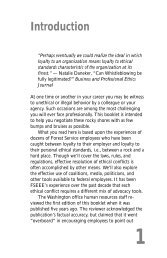Order Granting Preliminary Injunction - Forest Service Employees for ...
Order Granting Preliminary Injunction - Forest Service Employees for ...
Order Granting Preliminary Injunction - Forest Service Employees for ...
Create successful ePaper yourself
Turn your PDF publications into a flip-book with our unique Google optimized e-Paper software.
Case 3:05-cv-02220-SI Document 27 Filed 06/27/2005 Page 6 of 10<br />
1<br />
2<br />
3<br />
4<br />
5<br />
6<br />
7<br />
The administrative record reflects that the <strong>Forest</strong> <strong>Service</strong> considered the Timbered Rock Study<br />
“in<strong>for</strong>mative,” AR 449, but it relied instead, and apparently exclusively, on the suitable habitats designated by<br />
the U.S. Fish and Wildlife <strong>Service</strong>, which did not include severely-burned <strong>for</strong>est. Id. Indeed, by the time<br />
defendant received the Timbered Rock Study on April 15, 2005, AR 340, the biological assessment <strong>for</strong> the<br />
northern spotted owl had already been prepared <strong>for</strong> almost a month. AR 594. In that assessment, defendant<br />
stated that “given the effects of the Sims Fire, there is no suitable habitat within Critical Habitat Unit CA-30<br />
associated with any proposed unit.” AR 600. Thus, defendant held the view that severely burned <strong>for</strong>est could<br />
United States District Court<br />
For the Northern District of Cali<strong>for</strong>nia<br />
8<br />
9<br />
10<br />
11<br />
12<br />
13<br />
14<br />
15<br />
16<br />
17<br />
18<br />
19<br />
20<br />
21<br />
22<br />
23<br />
24<br />
25<br />
26<br />
27<br />
28<br />
not serve as a suitable habitat <strong>for</strong> the northern spotted owl be<strong>for</strong>e receiving the Timbered Rock Study. After<br />
receiving the study, there is no evidence in the record that defendant considered whether this evidence, along<br />
with Franklin’s submission, created even the possibility that extraordinary circumstances existed precluding the<br />
categorical exemption <strong>for</strong> this project. Instead, defendant simply stuck to its assertion that the northern spotted<br />
owl did not benefit from severely burned <strong>for</strong>est.<br />
Defendant submits the Youngblood declaration to explain why the Timbered Rock Study was found<br />
to merely be “in<strong>for</strong>mative.” However, even if the Court does consider the declaration, there is still evidence<br />
in the record that exceptions to the categorical exemption may apply, which is all that is required to prevent the<br />
use of the categorical exemption. It appears to the Court, at this early stage, that plaintiffs’ likelihood of success<br />
on the merits of the NEPA claim is less than it is <strong>for</strong> their NFMA claim, discussed below. However, plaintiffs<br />
could succeed on this claim because there is no evidence in the record that defendant ever considered whether<br />
the northern spotted owl benefits from a severely burned <strong>for</strong>est habitat.<br />
B. NFMA<br />
Plaintiff EPIC argues that the <strong>Forest</strong> <strong>Service</strong> has violated the NFMA because it failed to ensure that<br />
the Sims Project complied with the Six Rivers Land and Resource Management Plan (LRMP) and the<br />
Northwest <strong>Forest</strong> Plan (NFP). Specifically, plaintiff contends that these Plans require the <strong>Forest</strong> <strong>Service</strong> to<br />
show that all snags to be logged within the LSR are unlikely to persist. Defendant argues that the Plans do not<br />
require retention of all snags that are likely to persist, but only of some of them.<br />
The operative language of the Plans is vague, which leads to the dispute between the parties. Both<br />
6




